President's Message
Recently, there was a fascinating article in the Richmond Times-Dispatch about the discovery of a chemical hearth designed for laboratory experiments dating to an 1800s science program located in the Rotunda at the University of Virginia. The discovery was made while a renovation project was underway. It had been sealed into a wall when no longer in use and long forgotten. According to the article, the hearth may be the nation's oldest surviving example of chemistry education - a surprising find in one of the most studied buildings in the country.
Other recent and ongoing discoveries include artifacts found in archaeological excavation of the fort at historic Jamestown.
In October, descendants of one of the earliest settlers, Captain Thomas Harris, gathered here in Henrico. They visited the site where an archaeological discovery located the foundation of their ancestral home at Curles Neck and where a historic marker was erected in honor of their ancestor along the newly completed Virginia Capital Trail. The Virginia Capital Trail is a bicycle and pedestrian trail connecting Williamsburg, Jamestown (through Henrico) and Richmond along historic Route 5.
The Harris descendants also visited historic Jamestown where Dr. Kelso (who first discovered the site of the original James Fort) gave them a private tour. Of particular interest, the artifacts found at Jamestown relate to the exact period of time when Henrico was first founded from which the Harris descendants trace their ancestry - another unexpected find.
If you are interested in viewing the artifacts, information can be found at www.historicjamestowne.org, or Jamestown Rediscovery has a Facebook page where you can view amazing videos of the excavation.
The point I am making is history is not just in the past; it is constantly being rediscovered. Who knows - perhaps it will be rediscovered in your own back yard.
Sarah Pace,
President
>Back to Top<
December Quarterly Meeting
Our December Quarterly Meeting will be Sunday, December 6, 2015, starting at 2:30 P.M. The HCHS Board Meeting starts at 1:30 P.M. It takes place at Meadow Farm Orientation Center, which is located at 3400 Mountain Road in Glen Allen, VA 23060.
Santa Trains and More: Author Doug Riddell has written extensively on railroads and has coauthored Virginia's Legendary Santa Trains with former Miller & Rhoads Snow Queen, Donna Strother Deekens. Mr. Riddell will speak about Santa Trains and some of Richmond's railroad history.
>Back to Top<
Vintage Views of the Old Glen Allen RF&P Station
Our meeting this time is being held at Meadow Farm, and adjoining the property is the county's RF&P Park. Our speaker, Doug Riddell, will be speaking about the Santa trains and about local railroad history. He found these images in a collection that Mr. Wayne Sale had. These images of the station are extremely rare, especially those showing the station actually had a basement. They also show the freight building across the track. As Mr. Riddell says, "This is quite a find."
>Back to Top<
APHA Update: It's in the Bag (or Trailer)
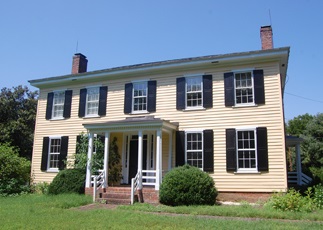
The Association for the Preservation of Henrico Antiquities has saved the 1857 house known as Burleigh, located in the Three Chopt District. The society spent $30,000 dismantling the house, labeling the components, and storing it in a trailer. The society hopes to find someone interested in reassembling it at another site, ideally in Henrico. The society will need to spend an additional $10,000 before the project is complete.
Additionally, the society has funded three road side markers: Captain Thomas Harris, The Carter Family, and Westhampton Settlement. These markers cost $1,600.
>Back to Top<
A Small Journal and Its Sporadically Made Entries Provide A Glimpse of Melrose Plantation
Melrose: Circled on the detail from the 1853 Smith map of Henrico County is the notation "J. N. Powell," marking the site of the family home.
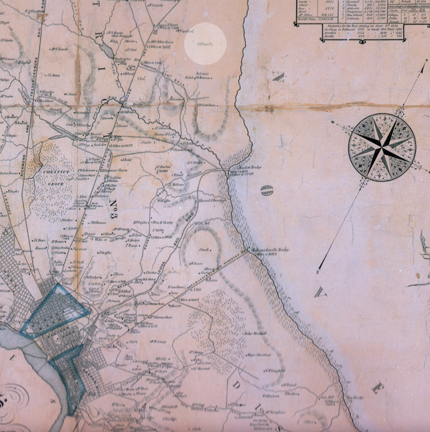
Dr. John Norment Powell, a prominent Henrico physician, was born in Westmoreland County, Virginia, in 1804. He received his medical degree from the University of Pennsylvania and on 1 February 1842 married Mary Catherine Wright, also of Westmoreland County. Afterwards, they lived at Melrose, northwest of Richmond near Yellow Tavern in Henrico County. They had three children: Junius Levert Powell, John J.A. Powell and Blanche Norment Powell.
Blanche married John William Drewry on 7 November 1867, and her descendants were apparently responsible for donation of four boxes of papers now housed in the Library of Virginia under the title Powell-Drewry Family Papers, 1828-1934.
While the largest part of the collection consists of letters to Blanche Norment Powell Drewry, it also contains genealogical material, slave lists, a will, postage stamps, Bible records and more.
One particular item in the collection is a small gray cardboard covered notebook about four inches wide and six inches tall containing 100 pages of unlined paper. It is a bit like a small version of today's composition books. While it may not be the most significant item in the Powell-Drewry Papers, it is certainly interesting reading.
At the top left of the first page is written "Mrs. Mary C. Powell" in a brownish ink matching many of the entries throughout the book. It seems relatively safe to conclude that Mrs. Powell is responsible for all the entries, pencil and pen, since a set of instructions "To dye cotton or wool brown" dated "Oct 16th 1862" is signed "Mary C. Powell" and this handwriting matches the inked items elsewhere in the journal.
The journal might have first served as a practice book for French and Latin because the back of that first page has the French terms il, elle, and la and their English translations. This is followed by 17 pages of what appears to be French writing exercises. There are also over ten pages of a Latin translation of a long piece where a few words of the piece are written in Latin, followed by a slash with the English translation.
In the pages between the two exercises and, in fact, in blank areas within the Latin work, entries unrelated to them are made. So Mrs. Powell apparently used the spaces in the book as she needed when she needed. It is not a particularly orderly compendium.
Instead, it is a hodgepodge of translations and language exercises, inventories of various household wares, recipes, remedies, clippings, thoughts on child rearing, a pencilled essay taken from "McClary's Oliver Goldsmith" and a 12-page "Catalogue of Junius L. Powell's school books taken down by his mother 1864."
The various entries were recorded over an eleven-year period with the earliest entry being an 18 May 1858 accounting of all the man's clothing (unfortunately, part of it is pasted over with newspaper clippings of cures and recipes) and the latest dated entries are a 23 May 1870 "Account for proceeds of gardening with George Carbina 1870" for slaves of cherries and strawberries and "Sales of wheat 1870." (The Library of Virginia's guide to the collection, however, indicates 1862-1868).
To read this journal is not by any means to get a complete picture of life in mid-nineteenth century Henrico, but it does provide brief glimpses into a prominent Henrico household and the priorities and interests of its mistress. Join us as we use this issue of the Newsletter to explore some of those interests.
>Back to Top<
Inventories: Keeping Count of the Household Goods
A recurring item in Mary Powell's journal is the inventory. In fact, two inventories are the first things we encounter in the journal on the back of the first page just below a list of three French terms. These particular entries are accounts of men's clothing:
Jan 27th, 1863. This day the Dr. has six perfectly good collars, and 4 new shirts not long being made. This day Junius has three perfectly good standing collars and four turn down or Byron collars. Johnnie has 3 perfectly good linen collars, and 1 marsellaise one that was Junius', but altered for Johnnie.
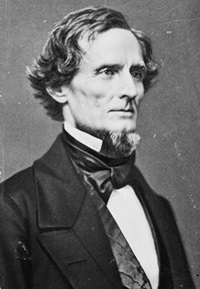
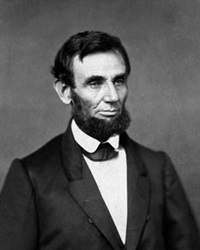
Collared. Jefferson Davis wears a collar in the "standing" or "turned up" style, while Abraham Lincoln is seen in the "turn down" or "Byron" collar so named after the Romantic English poet George Gordon Lord Byron. We would much appreciate any information about the marsellaise one" that Mrs. Powell mentions.
This day Jan 27th 1863 upon examination I find Johnnie has 7 excellent pairs of cotton socks, and one pair older ones but still pretty good.
While we might not think this a particularly extensive wardrobe, her collection of the family china seems rather plentiful. Inventories of the dishes appear regularly, and counting them seems to be a yearly activity. Following the above inventory are 17 pages of French exercises, then come three consecutive accountings of china:
Dec. 6th 1865 counted up china dinner sett and have 9 blue flat dishes of different sizes belonging to sett, 2 blue deep oyster dishes, 3 vegetable dishes with covers, 24 large size dinner plates same sett, 1 doz soup plates same sett, 1 doz deep ice cream or jelly plates of same sett; 22 pastry plates; 24 medium size dinner or breakfast plates, 11 fruit plates, 1 tureen and stand, 2 sauce tureens, 2 butter boats and stand. Of tea china have 8 cups & ten saucers. Have 8 glass tumblers, 3 rose tea plates, 8 breakfast or tea plates.
It is quite a set of china, and one that Mrs. Powell clearly wanted to keep an eye on, for the second accounting, made 4 September 1866, notes "23 large dinner plates (one missing since last counting)."
And then a third counting on 17 December 1867 counts only "20 large size dinner plates."
Possibly, this extensive set had been made necessary by losses to an earlier set. On 6 December 1859, Mrs. Powell "Took an inventory of old white china" and listed the items. Directly below this listing, she notes that on 20 November 1862, she "counted up and compared what is remaining with the above list much was gone."
Elsewhere, inventories of shirts, sheets, and pillowcases, as well as knives and pans and blankets appear, and often refer to the differences between them and earlier accountings. And they often appear penned into a space left blank after other unrelated journal entries.
>Back to Top<
Treatments: Curing Cholera Infanturum and Inflammations
Interestingly, Mrs. Powell's husband was a physician, Dr. John E. Powell; yet she offers in her journal treatments for several conditions. The following are two such treatments she offered for different conditions and one treatment for an apparently common nuisance:
Cure for cholera infanturum, diarrhea, colic, & c.
One fourth an ounce of clovers, pulverized
One fourth of an ounce of pulverized cinnamon
One fourth of an ounce of pulverized gum guaracum mixed with one pint of old and pure whiskey. To be well shaken before using. Dose for an adult, one half of a wine glass, or a large table spoonful filled up with water for a child proportionally. One dose if not chronic usually cures; if not it should be repeated 3, or 4, times daily.
For all inflammatory diseases, both internal and external, brandy and salt, is said to be specific.
Mode of preparation - to a portion of the best French brandy in a bottle add some common table salt and shake it well together, the settling of salt at the bottom will show that no more can be absorbed. Let it stand awhile, and use it as clear as possible. For external application use it pure; but when taken internally, the dose is one table spoonful of brandy and two of hot water. The warmer it can be drank [sic] the better.
"The following remedy for bed bugs is said to be infallible
Take two pounds alum, bruise it, and reduce it nearly to powder; dissolve it in three quarts of boiling water; letting it remain in a warm place till the alum is dissolved. This alum water is to be applied hot by means of a brush to every joint and crevice. White wash the ceiling and walls, putting in a plenty of alum, and there will be an end to them."
>Back to Top<
Civil War: Effects on the Homefront
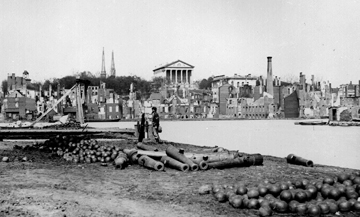
Richmond in ruins as seen from south of the James.
Oddly, only two entries in the journal have reference to the Civil War even though the booklet covers largely the years between 1862 and 1868. The first entry is as follows: "Sept 15th 1861 gave the soldiers 2 pairs blankets one pair coarse white with red and green borders, and one pair white with black borders.".
There is only one other mention of the war in the journal, but it was clearly on Mrs. Powell's mind because she includes a three-page overview of the events of 1865 across the South - Atlanta, Tennessee, etc. It seems as if it is a transcription of some other article or articles, and it is incomplete with page or more possibly missing at the end. It ends with this statement in a slightly different ink, which may indicate that she had copied the account of the events of the war then added her own local observations. She wrote,"Our currency which has depreciated has now become almost worthless, gold which is the standard at this time 17th Jan 1865 - $100 for 1. The prices of everything have increased in." And that's how it ends.
>Back to Top<
Recipes: Holiday Specialties from Melrose
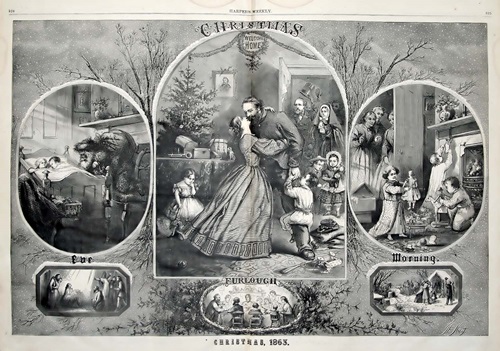
Fifteen pages of Mrs. Powell's journal are devoted to "Recipes for cooking many wholesome dishes." Some of the recipes are apparently hers, while she attributes many of the others to Mrs. Paleske, Mrs. D. Bass and Mrs. Joe Mayo.
Among the many recipes Mrs. Powell recorded at Melrose are Potatoe Pudding (sweet or Irish), Veal cutlets, Cocoa nut pudding, Macaroons, Force meatballs, Chicken Salad, Blancmange, Tomato Pickle (with a notation of "very good") and even instructions to make yeast (with the notation "Excellent").
We find the following directions for preparimg special dishes for the Christmas season. Perhaps they were enjoyed during occasions like those depicted in the illustration from Harper's Weelly.
Christmas Plum Pudding
A pound pudding should consist of a pound of suet cut in pieces not too fine; A lb of currants picked washed and well dried, a lb raisins stoned, 4 eggs, 1/2 a grated nutmeg, an oz citron and lemon peel shred fine, a teaspoonful beaten ginger; a little mixed spice, 1/2 lb bread crumbs, 1/2 lb flour, and a pint of milk. Beat the eggs first, add half the milk, beat them together, and by degrees stir in the flour then the suet, spice & fruit, and as much milk or brandy as will mix it together very stiff. Then take a clean cloth, dip in boiling water and squeeze it dry Have ready a pot of water boiling fast into which drop your pudding and keep it boiling five hours. If necessary, the pot should be replenished with boiling water from a tea kettle.
Egg Nog
Use 5 or 6 eggs to half a gallon of milk. Beat the whites and yolks separately, bring the milk to a boil and then add the yolks. Sweeten to your taste and then add the quantity of brandy you prefer. The milk may be either cold or warm but is better warm.
>Back to Top<
Childcare: A Few Thoughts Original and Selected on the Training and Education of Children
Under the heading above, Mrs. Powell recorded the following opinions:
A child's mind should not be cultivated at the expense of heart, and feelings, but each should receive due share of attention and cultivation.
A strict adherence to duty, in all relations, and walks of life, for "The path of duty is the path of safety," should be impressed on children, by parents, and teachers; for example, duty to God, to parents, to teachers, to brothers, and sisters, to servants, to friends and acquaintances in general, and to themselves. Duty! What a world of meaning and import is comprised in that one word. It is well nigh the sum, and substance of human life, and human happiness, for upon the faithful performance or neglect of our duty, depends our happiness, and welfare in this world, as well as that which is to come. Often impress upon our children of both sexes; a strict and faithful performance of every duty. Love is the basis, of all true joy, and pleasure. Selfishness is the bane of life - the darkener and destroyer of home. Why will not men believe it? Impress it on the minds of children, ye who have the care of them. Children beware of bad habits. The habit you put on playfully, and thoughtlessly, not may cling to you closer than the fabled poisoned shirt, and torment you when you become powerless to shake it off."
>Back to Top<
Textiles: Producing Colors to Dye For
Think of a fabric store with bolt after bolt of goods in every color and pattern imaginable. Think of a clothing store when each season brings its own new color. The possibilities for personal attire, made or bought, are endless. Not so in the middle of the nineteenth century. You made our clothes, and the colors of the cotton or wool you used was quite limited - white. Mrs. Powell had methods of varying the textile palette with these processes for producing dyes and using them:
To dye cotton or wool brown
Take the bark of the root of the common wild plum, boil in iron or brass, as most convenient, until the dye looks almost black. Strain and add a small quantity of copper as dissolved in a small quantity of the dye. Add the articles to be dyed and boil and hour or so. Wring out and dip in strong cold lye. When dry, rinse in cold water. This gives a genuine bright brown, which is the prettiest contrast for blue and when checked in together makes dress becoming enough to the proudest Southern dame or bell. Ladies try it.
Oct 16th 1862 Mary C Powell.
The next week she wrote:
Oct 23rd 1862 gave out 80 [840 yards] hanks of cotton to be boiled and sized for winding.
And later in the journal she explains this procedure:
A quick method of dying cochineal red
For 1 lb yarn take 1 1/2 oz cream tartar, 1 1/2 oz cochineal, 2 oz solution of tin, put the cream tartar in warm water in a tin vessel, when dissolved put in the cochineal, stir it, when it gets hot enough to boil, put in the solution of tin, wet your yarn, put it in the dye & boil it 30 minutes, stirring it all the time. Then take your hanks, and put them in a tub of cold water, and rinse them well."
>Back to Top<
In Conclusion
This is quite a diverse collection. And we haven't even included hen-and-egg inventories, gardening records of strawberry and cherry sales and what harvest records - just to name a few.
But what do we take away from all this? For one thing, we see a basic need to record and preserve, and that preservation is for the information (treatments to be used, recipes to be followed), feelings (thoughts on childcare, and a half page not covered elsewhere where Mary appears to be practicing signing her name and mailing address "Care Dr. J. N. Powell" - a new wife celebrating her new name and address?) and the objects in the inventories themselves (subsequent lists to be compared for loss).
More importantly, it seems to be the embracing of a simpler life where possessions were not so plentiful and tasks were. We might find the focus on those mundane, but it is probably a focus that we might do well to adopt.
Joey Boehling
>Back to Top<
Now You Know
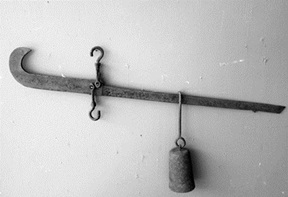
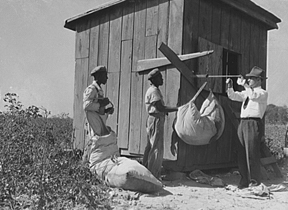
On tobacco and cotton farms, steelyards were a weighty matter.
Congratulations to Randall Benton, John I. Jacobsen and Ron Grubs, all of whom identified the last issue's mystery object. However none of them provided the name of the scale. Messrs. Benton, Jacobsen and Grubbs identified the item as a tobacco scale. The device, commonly known as a steelyard, was also used for weighting cotton.
When in use, the topmost hook was attached to a barn beam or even a tripod that could be carried out into the field. The material to be weight was hung from the bottom hook, and the weight was slid along the serated bar until it balanced the load. This particular steelyard could handle material weighting up to 500 pounds.
It is interesting that Mrs. Mary Powell even mentions steelyards in her journal featured in this quarter's newsletter. Making a note about a recent weighing of cotton for weaving, she recorded, "By the small balance 19 lbs of cotton left for next warping. The same cotton weighed by the steelyards was 15 lbs." Which was more accurate is hard to say.
Steelyards came in many sizes; and, of course, they were not limited to tobacco and cotton, a variation even used for weighing babies in pediatrician's offices of old.
In the field. This image from the Libary of Congress shows men weighing a bag of cotton harvested from Marcella Plantation in Mississippi in 1939.
>Back to Top<
What Do You Know?
Pasted into Mary C. Powell's small journal is a handwritten slip with the following information on it:
25 bear is allowed to a 500 slaie
20 bear is allowed to a 400 slaie
40 threads of warp to a bear
To the harness which you brought there are only
30 bear containing from 9 to 13 eyes. The harness should
contain to each 500 sheet eyes to hold the warp
which is warped to 25 bear, which makes 1000
threads of the warp at 40 threads of warp to a bear;
50 bear to an 800 slaie.
Do you know what this refers to, what the rather odd terms are and what the directions mean?
Email your answers to jboehling@verizon.net.
>Back to Top<
News 2015: Fourth Quarter
First Quarter | Second Quarter | Third Quarter
Home | Henrico | Maps | Genealogy | Preservation | Membership | Shopping | HCHS
|











